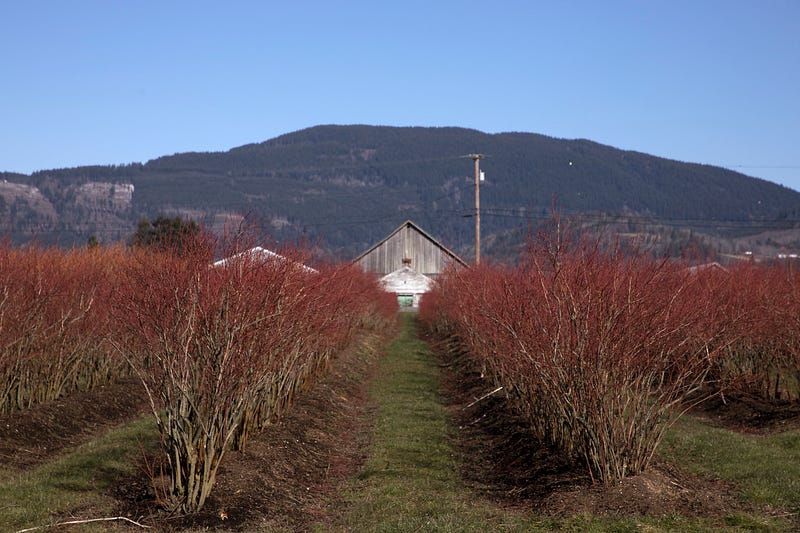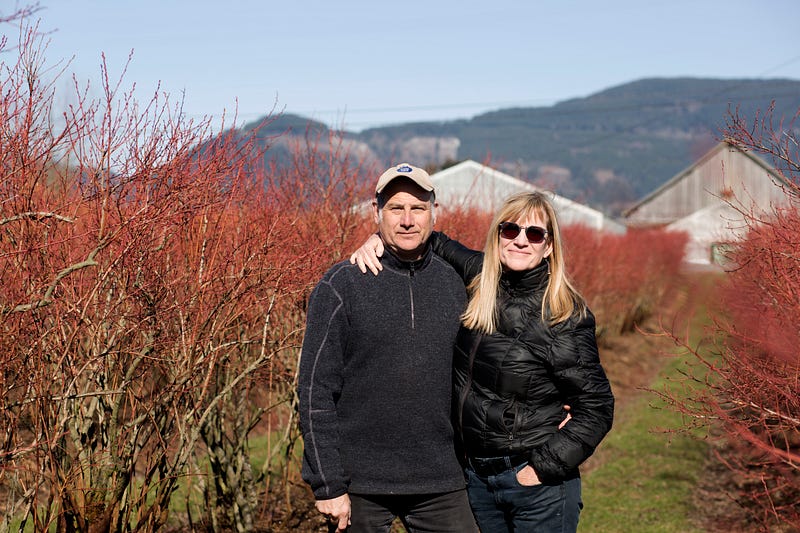Heirlooms of Bow Hill
The renewed legacy of the oldest blueberry farm in Skagit Valley
By Grace Westermann

The blueberry bushes at Bow Hill Blueberries stand regal in their rows, roots hibernated in frozen mud under a pale pink sky. At 72 years old, the vines aren’t about to be rushed.
This field of sleeping beauties will welcome heaps of bright blue berries come summer, continuing its legacy as the oldest blueberry farm in the Skagit Valley.
Inside the farmhouse, owners Susan and Harley Soltes lean against their kitchen island, backlit by a bright morning sun and ready for a day of pressing, dehydrating and pickling blueberries.
They found and renamed the farm “Bow Hill Blueberries” in 2011 to serve as a new adventure for them and to satisfy people’s hunger for the tiny blue fruit.
Susan, a film director in advertising, and Harvey, a photojournalist, pursued their individual successful careers for 25 years.
“I’m a farmer by marriage,” Susan said. “I had done the film thing and just wanted something new, and I said, ‘Hey I’ll farm with you as long as we do it in Skagit Valley.’ And that’s when we found the blueberry farm.”
The U.S. is the largest blueberry producer in the world, and Washington state is the largest blueberry producer in the nation, according to Washivor, a Washington state website for agricultural education.
An Eastern Washington native, Susan said she felt like farming was always in her somewhere.
Harley had dreamt about becoming a farmer since he was a child.
In the beginning, the Soltes didn’t set out to be blueberry farmers. They had a 40-acre farm west of Edison and lived in a trailer. The blueberry farm was appealing to them because it had a house, a processing facility and a distinct history.
The farm was conceived in 1947 by the Anderson Family in Bow, Washington. Susan said the blueberry plants are desirable because they’re an heirloom fruit.
Heirlooms are historic plant varieties refined by generations of gardeners and known for their delectable taste, according to an article by Farm and Dairy. To be considered heirloom, the plant must be more than 50 years old.
It wasn’t enough to own a historic blueberry farm for the Soltes. They wanted to transform the blueberries to being as pure as possible by sticking to their organic values they practiced at their other farm.
The organic transition takes three years, according to the USDA. From day one, growers must start everything organically in order for the previous chemicals from conventional farming to break down and disappear from the soil.



While transitioning, farm and labor costs are greater than using organic methods and having to sell the fruit at conventional prices until they can be labeled “certified organic.”
Despite jumping through the hoops of certification, the Soltes had their first organic blueberry harvest in 2014. With success came obstacles.
“Growing organic fruit in the Northwest is challenging because it’s so wet; you have to combat fungal diseases through organic methods,” Harley said.
The farm uses fermented antibacterial products like clove and orange oils that can be very expensive, and they combine mechanical pruning methods to allow for more air flow.
It’s a challenging process, but they wouldn’t do it any other way. Their employees and the people who walk through the blueberry field are safe from pesticides used in a conventional field.
For their small five-acre farm, Harley said they complete as much paperwork as a 100-acre, non-organic blueberry farm.
“Washington State Department of Agriculture goes over everything we do,” he said. “But that’s what gives the logo of ‘organic’ integrity. You pay for it, but it keeps the system honest.”
Back in the kitchen, Susan took a sip of pressed heirloom blueberry juice made on the farm and elaborated on what she appreciates about her job now.
“[In advertising] I used to sell all kinds of things. I would sell things to people that they didn’t need, and I would think as I’m filming, ‘People don’t need this. Why am I doing this?’” she said. “People might not need a blueberry, but at least it’s good for them.”
Outside, the sun was beating down and the air was crisp. An occasional honey bee from the Soltes’ bee hives whizzed by in search of its next plant to pollinate.
Harley walked through the field, his boots lined with mud that had began to ooze out of its frozen form.
“We didn’t invent this place. This is a continuation of what the Andersons did for 65 years,” he said.
The blueberry plants are the star of the show, but on top of their soil and in the surrounding field lies a community of life that grows and sustains their production.
A succulent called purslane grows as a cover crop, choking any surrounding weeds. Later in the year, thousands of sunflowers will grow to help feed the bees for blueberry pollination.
The farm is an organic team effort between the land, its farmers and the community that supports it. Until their seasonal debut, the blueberry buds will remain dormant.
“The blueberries are different every year, they’re like a snowflake,” Susan said. “Every harvest will be different and you don’t know what’s going to happen.
